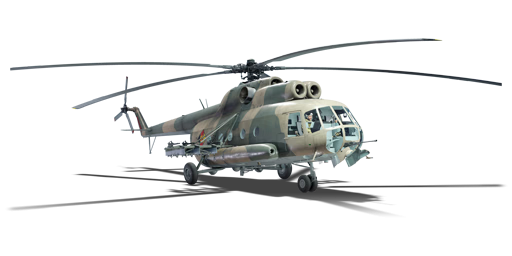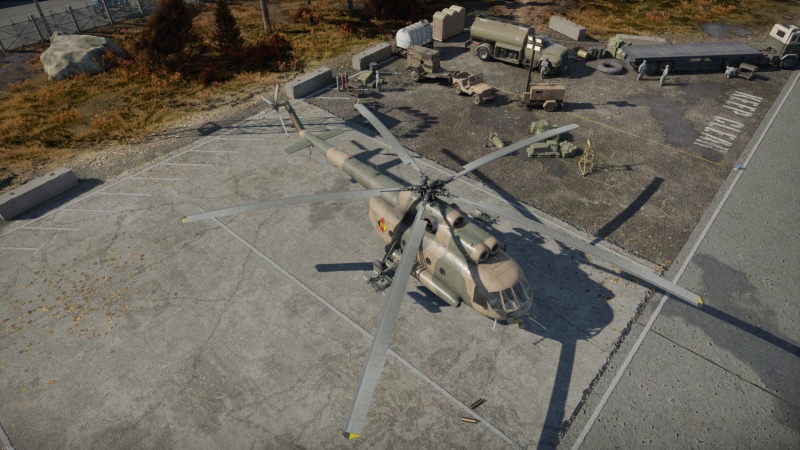Difference between revisions of "Mi-8TB (Germany)"
Colok76286 (talk | contribs) (Edits) |
(→Description) |
||
| Line 11: | Line 11: | ||
== Description == | == Description == | ||
<!-- ''In the description, the first part should be about the history of and the creation and combat usage of the helicopter, as well as its key features. In the second part, tell the reader about the helicopter in the game. Insert a screenshot of the vehicle, so that if the novice player does not remember the vehicle by name, he will immediately understand what kind of vehicle the article is talking about.'' --> | <!-- ''In the description, the first part should be about the history of and the creation and combat usage of the helicopter, as well as its key features. In the second part, tell the reader about the helicopter in the game. Insert a screenshot of the vehicle, so that if the novice player does not remember the vehicle by name, he will immediately understand what kind of vehicle the article is talking about.'' --> | ||
| − | The ''' | + | The '''Mi-8TB''' was an export modification of the Soviet [[Mi-8TV]], developed in 1968. Its main difference from helicopters in service with the Soviet army was the replacement of the 9M17M "Falanga" ATGM complex with the 9M14M "Malyutka". The helicopter was exported to many countries, in particular, to East Germany, where over 100 Mi-8s of various modifications were supplied. By reunification of Germany in the 1990s, a small number of outdated Mi-8TBs remained in East Germany, as the replacement process with Mi-8MT and Mi-8MTV-2 had not been completed due to the withdrawal of Soviet troops from Germany. The last Mi-8TBs disappeared from German skies in 1992, but some still exist in museums around the country. |
| + | |||
| + | Introduced in [[Update "Sons of Attila"]], the German Mi-8TB differs from the [[Mi-8TV]] only in having six "Malyutka" ATGMs instead of four "Falanga" missiles. In all other respects, the machines are identical - they can carry a large number of rocket pods and bombs, but their enormous size and weight prevent them from actively manoeuvring between trees and terrain, making it quite difficult for them to evade enemy fire. | ||
== General info == | == General info == | ||
| Line 99: | Line 101: | ||
== History == | == History == | ||
<!-- ''Describe the history of the creation and combat usage of the helicopter in more detail than in the introduction. If the historical reference turns out to be too long, take it to a separate article, taking a link to the article about the vehicle and adding a block "/History" (example: <nowiki>https://wiki.warthunder.com/(Vehicle-name)/History</nowiki>) and add a link to it here using the <code>main</code> template. Be sure to reference text and sources by using <code><nowiki><ref></ref></nowiki></code>, as well as adding them at the end of the article with <code><nowiki><references /></nowiki></code>. This section may also include the vehicle's dev blog entry (if applicable) and the in-game encyclopedia description (under <code><nowiki>=== In-game description ===</nowiki></code>, also if applicable).'' --> | <!-- ''Describe the history of the creation and combat usage of the helicopter in more detail than in the introduction. If the historical reference turns out to be too long, take it to a separate article, taking a link to the article about the vehicle and adding a block "/History" (example: <nowiki>https://wiki.warthunder.com/(Vehicle-name)/History</nowiki>) and add a link to it here using the <code>main</code> template. Be sure to reference text and sources by using <code><nowiki><ref></ref></nowiki></code>, as well as adding them at the end of the article with <code><nowiki><references /></nowiki></code>. This section may also include the vehicle's dev blog entry (if applicable) and the in-game encyclopedia description (under <code><nowiki>=== In-game description ===</nowiki></code>, also if applicable).'' --> | ||
| − | This combat-ready version of the Mi-8 was developed based on the Mi-8T model in 1974. The "TV" designation stands for "Transportno-Vooruzhenny," literally meaning "Transport-Armed." The helicopter was equipped with a movable 12.7mm machine gun in the nose, along with six pylons designed to carry a wide variety of suspended weaponry, including the Falanga anti-tank guided missile. This armament package brought the | + | This combat-ready version of the Mi-8 was developed based on the Mi-8T model in 1974. The "TV" designation stands for "Transportno-Vooruzhenny," literally meaning "Transport-Armed." The helicopter was equipped with a movable 12.7mm machine gun in the nose, along with six pylons designed to carry a wide variety of suspended weaponry, including the Falanga anti-tank guided missile. This armament package brought the helicopter's combat ability roughly in line with early versions of the Mi-24. Despite being modified for combat, the helicopter retained its full troop transport functionality, being able to carry up to 23 soldiers, who could also fire their weapons through loopholes installed in the windows. The Mi-8TV helicopters were produced in limited numbers in Kazan. They were used for various roles in tandem with the Mi-24 and were also supplied to border patrol and naval aviation units. |
The German Mi-8TB is an export version capable of carrying up to 6 "Malyutka" ATGMs. | The German Mi-8TB is an export version capable of carrying up to 6 "Malyutka" ATGMs. | ||
Latest revision as of 16:44, 4 August 2024
| This page is about the attack helicopter Mi-8TB (Germany). For other versions, see Mi-8 (Family). |
Contents
Description
The Mi-8TB was an export modification of the Soviet Mi-8TV, developed in 1968. Its main difference from helicopters in service with the Soviet army was the replacement of the 9M17M "Falanga" ATGM complex with the 9M14M "Malyutka". The helicopter was exported to many countries, in particular, to East Germany, where over 100 Mi-8s of various modifications were supplied. By reunification of Germany in the 1990s, a small number of outdated Mi-8TBs remained in East Germany, as the replacement process with Mi-8MT and Mi-8MTV-2 had not been completed due to the withdrawal of Soviet troops from Germany. The last Mi-8TBs disappeared from German skies in 1992, but some still exist in museums around the country.
Introduced in Update "Sons of Attila", the German Mi-8TB differs from the Mi-8TV only in having six "Malyutka" ATGMs instead of four "Falanga" missiles. In all other respects, the machines are identical - they can carry a large number of rocket pods and bombs, but their enormous size and weight prevent them from actively manoeuvring between trees and terrain, making it quite difficult for them to evade enemy fire.
General info
Flight performance
The Mi-8TB shares its speed with the Soviet Mi-8TV having a decent top speed of 260 km/h. This lets the Mi-8TB fly faster than most other helicopters seen at its BR. So getting into the battlefield (and away from it) fast shouldn't be a problem!
| Characteristics | Max speed (km/h at 1,000 m) |
Max altitude (metres) | |
|---|---|---|---|
| AB | RB | ||
| Stock | 251 | 243 | 4950 |
| Upgraded | ___ | ___ | |
Survivability and armour
The Mi-8TB has almost no armour to speak of, except some 8 mm steel and a small 50 mm bulletproof glass protecting the crew, making it very vulnerable to even small-calibre machine guns.
Modifications and economy
Armaments
Offensive armament
The Mi-8TB (Germany) is armed with:
- 1 x 12.7 mm A-12.7 machine gun, nose turret (700 rpg)
Suspended armament
The Mi-8TB (Germany) can be outfitted with the following ordnance:
| Default weapon presets | |
|---|---|
| |
Usage in battles
This helicopter can carry a variety of weapons such as its main gun, rockets, AGMs and bombs to deal with every kind of ground vehicles you can possibly face; Choose the loadout according to the situation of the battle, if there are no enemy SPAA on the battlefield you can feel free to take rockets or bombs and get close to enemy tanks to unleash your bombs or rockets on them but if there are enemy SPAA or aircraft present on the battlefield take caution and try to use AGMs to launch them at the enemy SPAA from a distance so it is harder for them to spot you but be aware that most of the SPAA vehicles at this battle rating have access to radars and can know of your presence so always try to keep your profile low and use objects on the map to hide yourself behind them like trees and mountains, it is also a good practice to fly down after launching each AGM because being afloat on the sky and not moving at all will make you easy to hit for enemy tanks, try to have a pick-a-boo style of play always fly down only come up to launch a missile and immediately go down behind a mountain or tree to avoid getting hit after the missile has reached the target and come back up only after making sure that it is safe.
Try to avoid enemy aircraft as it requires a lot of luck or skill to hit the enemy aircraft manually with only your main gun because you do not have any kind of anti-aircraft missiles to protect yourself but thanks to your powerful main gun you can easily hunt enemy helicopters since they fly slow and it is easy to get a lead on them.
Pros and cons
Pros:
- Can carry a relatively large amount of different kinds of weapons at its rank
- The main gun has a large amount of ammo and is powerful enough to easily knock out most light vehicles at this battle rating
Cons:
- Does not have any weapons to deal with aircraft except its main gun which must be manually aimed and cannot lock on and follow enemy aircraft's lead
- Does not have a Ballistic Computer so the gun and rocket reticles are not 100% accurate
- A relatively large profile makes it easy to hit this helicopter even for non-SPAA vehicles
History
This combat-ready version of the Mi-8 was developed based on the Mi-8T model in 1974. The "TV" designation stands for "Transportno-Vooruzhenny," literally meaning "Transport-Armed." The helicopter was equipped with a movable 12.7mm machine gun in the nose, along with six pylons designed to carry a wide variety of suspended weaponry, including the Falanga anti-tank guided missile. This armament package brought the helicopter's combat ability roughly in line with early versions of the Mi-24. Despite being modified for combat, the helicopter retained its full troop transport functionality, being able to carry up to 23 soldiers, who could also fire their weapons through loopholes installed in the windows. The Mi-8TV helicopters were produced in limited numbers in Kazan. They were used for various roles in tandem with the Mi-24 and were also supplied to border patrol and naval aviation units.
The German Mi-8TB is an export version capable of carrying up to 6 "Malyutka" ATGMs.
- From Devblog
Media
- Skins
- Videos
See also
- Related development
External links
Paste links to sources and external resources, such as:
- topic on the official game forum;
- other literature.
| Mil Moscow Helicopter Plant | |
|---|---|
| Attack | Mi-4AV |
| Mi-8AMTSh · Mi-8AMTSh-VN · Mi-8TV | |
| Mi-24A · Mi-24P · Mi-24V | |
| Mi-28N · Mi-28NM | |
| Mi-35M | |
| Export | ◊Mi-8TB |
| ▂Mi-24D · ◔Mi-24D · ◔Mi-24V · ◔Mi-24P · ◊Mi-24P · ◄Mi-24P HFS 80 · Superhind | |
| Mi-28A | |
| ▄Mi-35M | |
| Germany helicopters | |
|---|---|
| Attack | |
| Hip | ◊Mi-8TB |
| Hind | ◊Mi-24P · ◄Mi-24P HFS 80 |
| Tiger | EC-665 Tiger UHT |
| Utility | |
| BO 105 | BO 105 CB-2 · BO 105 PAH-1 · BO 105 PAH-1A1 |
| Alouette | ◄SA 313B Alouette II |
| Huey | ◄UH-1D |





